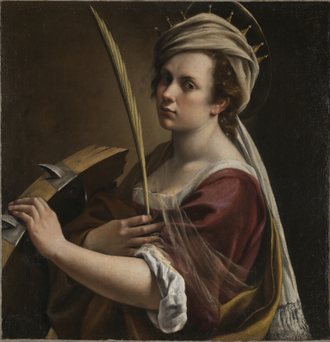Artemisia at the National Gallery

Artemisia - self portrait as St Catherine
Born in 1593, Artemisia Gentileschi was a celebrated artist of the Italian Baroque. The only daughter of noted painter Orazio Gentileschi, she was trained at home alongside her three brothers.
Caravaggio was a family friend and she emulates his passionate storytelling and dramatic use of light and shadow whilst imposing her own style in a definitive feminine perspective. Her paintings were sought after throughout Europe including by the Florentine Medici Court, Philip 1V of Spain and England's King Charles 1.
A superb exhibition at the National Gallery displays thirty paintings alongside two by her father, two portraits of her by other artists and a chalk drawing of 'The Right Hand of Artemisia Holding a Brush.'
Her portrayals of biblical and classical scenes depict women as strong, vibrant heroines in cinematic narrative. Aged seventeen she painted 'Susannah and the Elders' in 1610. It was also her last known subject forty two years later. She completed four versions in her career.
A few months after her first striking depiction of Susannah's vulnerability, being ogled by two leering men - one older and one younger - she was brutally raped by Agostino Tassi, who worked in her father's workshop, abetted by an older colleague who unsuccessfully also attempted rape but was beaten off by Artemisia. A subsequent trial lasted seven months. Artemisia endured the 'sibylle' torture, where cords were tightened around her fingers to ascertain the veracity of her judicial declaration.
A transcript of the trial is exhibited for the first time. Tassi was found guilty and sentenced to banishment which was only enforced later when he committed other crimes.
Artemisia was married off to a minor Florentine artist acquaintance of her father's and lived in Florence for seven years until 1620. She bore four children, but only her daughter, Prudenza survived childhood.
Emerging from her father's shadow, Artemisia, far from being a victim proved her fortitude and independence as an accomplished painter. She taught herself to read and write and established contacts that enabled her access to the Florentine court and ultimately to ruler Cosimo Medici . It is recorded that she performed at the Villa Medici in 1615 so her self portrait as a lute player may well be a representation of that occasion.
Rediscovered in 2017, her self portrait as St Catherine of Alexandria was purchased by the National Gallery in 2018 and was the inspiration for this retrospective. Her hand rests on the martyrs' attribute, the broken spiked wheel, instrument of the torture, which failed to kill her. (She was later beheaded). Artemisia's own unbroken spirit shines through in her commanding gaze and stance, holding the martyrs palm as if it were a paintbrush.
Two versions of her iconic Judith Beheading Holofernes hang side by side. Judith's maidservant is given prominence in pinning the Assyrian general down whilst Judith determinedly severs his head The later picture uniquely portrays' both women's blood spattered arms and clothing with remarkable detail. Frequently interpreted as her fantasy revenge for her violation by Tassi it is a powerful testimony to her great talent as a storyteller.
Artemisia was accepted as the first woman into Florence's great Academy of Arts. She moved in intellectual circles and befriended Galileo. Another exceptional rediscovered masterpiece is 'Mary Magdalene in Ecstasy'. Mary leans back, her hands clasping her knees. Eyes closed she is transported by the sounds of unseen angelic choirs into heavenly rapture.
Beset by debts and separated from her husband, Artemesia moved back to Rome. After a decade she settled in Naples where she ran a successful studio with her daughter, sometimes collaborating with leading Neapolitan artists until her death around 1654. Artemisia painted her first altar pieces in Naples, two of which of which feature in the exhibition.
Around 1638 - 39 Artemisia went to London where her ailing father was court painter. The finale of this breathtaking display focus' on her time there .She may well have helped complete her father's ceiling at the Queen's House at Greenwich as he died in February 1639.
She painted 'Self Portrait as the Allegory of Painting' in her forties for Charles the First and it remains in the Royal Collection .It is not a literal self portrait but a dynamic exposition of a woman artist at work, who had declared, "... you will find the spirit of Caesar in the soul of a woman," and "I will show your Lordship what a woman can do."
The Artemisia Exhibition is at the National Gallery from 3 October 2020 - 24 January 2021
Admission charge. Concessions available.
For more information see: www.nationalgallery.org.uk


















